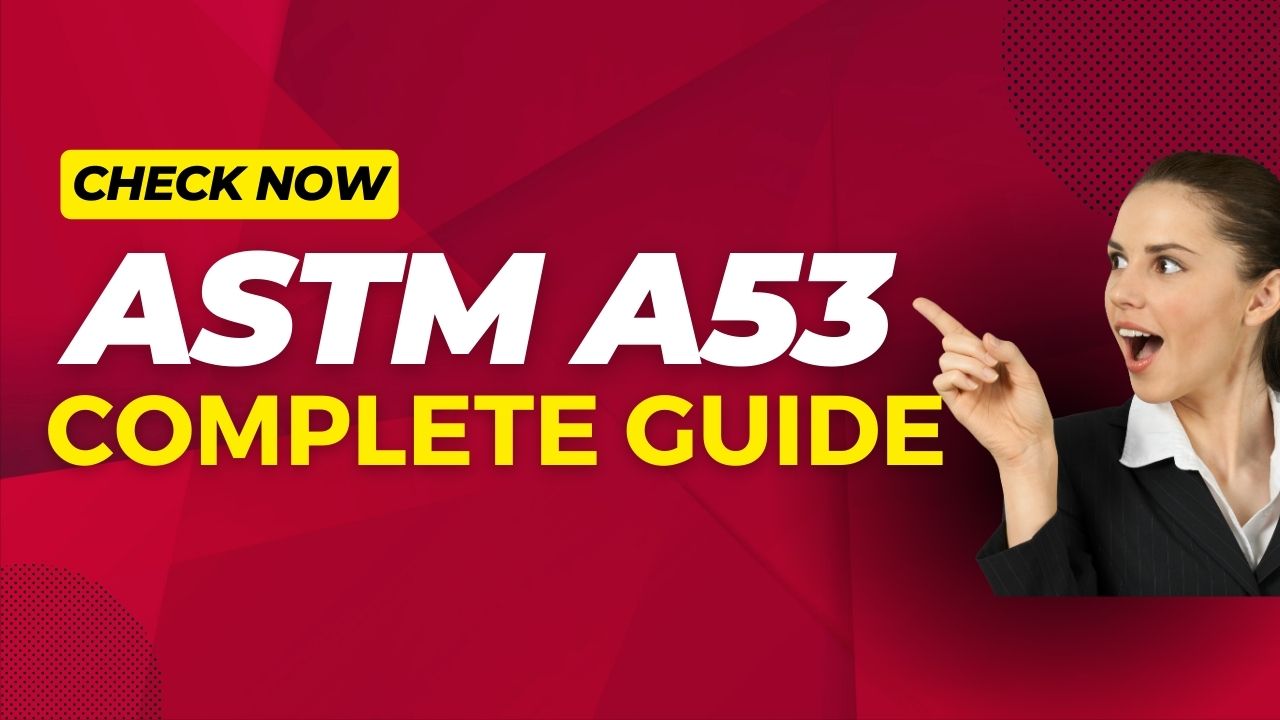1. Introduction
Steel pipes play a vital role in modern infrastructure, serving as the lifelines for transporting fluids and gases across various industries. ASTM A53 is a crucial standard in the world of steel pipes, setting specifications for pipes used in plumbing, mechanical, and pressure applications. This comprehensive guide will delve into the intricacies of ASTM A53 steel pipes, covering grades, chemical composition, mechanical properties, manufacturing processes, pros and cons, applications, standards, quality control, ordering information, and comparisons with other ASTM standards.
Table of Contents
Do not miss the detailed course 7 Modules of Piping Codes & Standards
Enrollment link
Check out the Similar Articles on ASTM Standards
The Significance of Steel Pipes
Steel pipes are essential components in industries such as construction, oil and gas, water supply, and more. Their durability, versatility, and reliability make them indispensable for conveying liquids and gases over long distances.
Role of ASTM Standards
The American Society for Testing and Materials (ASTM) develops and maintains standards that ensure the quality, safety, and performance of materials used in diverse applications. ASTM A53 stands as a prime example of such standards, providing guidelines for the manufacturing and use of steel pipes.
2. Various Grades
ASTM A53 encompasses different grades, each designed for specific applications and environments.
Differentiation Based on Application
ASTM A53 is classified into three grades: A, B, and C, with varying chemical compositions and mechanical properties to cater to different requirements.
Comparison of Key Properties
| Grade | Tensile Strength (MPa) | Yield Strength (MPa) | Elongation (%) |
|---|---|---|---|
| A | 330 | 205 | 28 |
| B | 415 | 240 | 22 |
| C | 485 | 275 | 21 |
3. Chemical Composition
Understanding the chemical composition of ASTM A53 steel pipes is essential as it directly affects their properties and performance.
Key Elements and Their Influence
- Carbon (C): Affects strength and hardness.
- Manganese (Mn): Enhances strength and workability.
- Phosphorus (P): Should be kept low to avoid embrittlement.
- Sulfur (S): Should be minimized for better weldability.
Chemical Composition (%)
| Element | A | B | C |
|---|---|---|---|
| Carbon | 0.25 | 0.30 | 0.30 |
| Manganese | 0.95 | 1.20 | 1.20 |
| Phosphorus | 0.05 | 0.05 | 0.05 |
| Sulfur | 0.045 | 0.045 | 0.045 |
4. Mechanical & Chemical Properties
The mechanical and chemical properties of ASTM A53 steel pipes are pivotal in determining their suitability for various applications.
Mechanical Properties
- Tensile Strength: The maximum stress a material can endure without breaking.
- Yield Strength: The stress at which permanent deformation begins.
- Elongation: The ability to stretch without breaking.
- Hardness: Resistance to indentation.
Chemical Properties
- Corrosion Resistance: Critical for pipes used in corrosive environments.
- Weldability: The ease with which the material can be welded.
| Property | A | B | C |
|---|---|---|---|
| Tensile Strength | 330 MPa | 415 MPa | 485 MPa |
| Yield Strength | 205 MPa | 240 MPa | 275 MPa |
| Elongation | 28% | 22% | 21% |
| Hardness | Not Specified | Not Specified | Not Specified |
| Corrosion Resistance | Good | Good | Good |
| Weldability | Excellent | Excellent | Excellent |
5. Manufacturing Process
The production of ASTM A53 steel pipes involves a series of well-defined steps to ensure consistency and quality.
Step-by-step Explanation
- Raw Material Selection: Quality steel coils or plates are chosen as the starting material.
- Uncoiling and Straightening: The material is uncoiled and straightened for processing.
- End Shearing: Cutting the material to the required lengths.
- Edge Milling: Milling the edges for precise geometry.
- Forming: Forming the flat strip into a round shape.
- Welding: High-frequency resistance welding creates a strong bond.
- Cooling: Pipes are cooled and sized.
- Sizing: Sizing to achieve the desired dimensions.
- Cutting: Cutting pipes to specified lengths.
- Testing: Pipes undergo various tests to ensure quality.
- Coating and Marking: Pipes may be coated or marked as per requirements.
6. Pros & Cons
Like any material, ASTM A53 steel pipes have their share of advantages and limitations.
Advantages
- Cost-Effective: A53 Grade A offers an economical option for general-purpose applications.
- Widely Available: A53 pipes are readily available from numerous manufacturers.
- Versatile: Suitable for a wide range of applications, from plumbing to structural use.
Limitations
- Lower Strength: Grade A has lower strength compared to Grade B and C.
- Limited Corrosion Resistance: While suitable for many environments, it may not be ideal for highly corrosive conditions.
- Not for High-Pressure Applications: A53 is not designed for high-pressure or high-temperature applications.
7. Applications
ASTM A53 steel pipes find application in various industries due to their affordability and versatility.
Wide Range of Industries
- Plumbing: Water and gas distribution.
- Construction: Structural supports, scaffolding, and fencing.
- Oil and Gas: Transport of oil and gas in low-pressure applications.
- HVAC Systems: Air ducts and ventilation.
- Mechanical and Pressure Applications: Machinery and equipment.
Key Properties for Applications
- Cost-effectiveness for budget-conscious projects.
- Weldability for easy installation and repair.
8. Codes & Standards
ASTM A53 steel pipes adhere to specific codes and standards to ensure safety and performance.
Compliance with Codes
- ASME B36.10M: Specifies dimensions and weights for steel pipe.
- ASTM A530/A530M: Standard specification for common requirements for specialized carbon and alloy steel pipe.
Industries Relying on Standards
Industries such as construction, plumbing, and mechanical engineering adhere to these standards for quality assurance.
9. Quality Control & Testing
Quality control plays a pivotal role in the manufacturing of ASTM A53 steel pipes to ensure consistent and reliable performance.
Quality Assurance Measures
- Chemical Analysis: Verifies compliance with chemical composition requirements.
- Mechanical Testing: Ensures pipes meet specified mechanical properties.
- Non-Destructive Testing: Detects surface and internal defects.
- Hydrostatic Testing: Checks pipes for leaks under pressure.
10. Ordering Information
To ensure the correct ASTM A53 steel pipes are obtained, precise ordering information is essential.
Essential Details
- Grade: Specify the appropriate grade (A, B, or C).
- Size: Provide dimensions such as nominal size and wall thickness.
- Length: Indicate the required pipe lengths.
- End Finish: Specify the type of end finish (plain, threaded, beveled, etc.).
11. Comparison with Other ASTM Standards
Comparing ASTM A53 with related standards helps users make informed decisions.
Comparative Analysis
| Parameter | A53 | A106 | A500 |
|---|---|---|---|
| Tensile Strength (MPa) | Varies | 415-655 | Varies |
| Yield Strength (MPa) | Varies | 240-415 | Varies |
| Elongation (%) | Varies | 30% | Varies |
| Corrosion Resistance | Good | Good | Good |
| High-Temperature Service | Limited | Yes | No |
12. Conclusion
ASTM A53 steel pipes have established themselves as a cost-effective and versatile solution for various applications. Their ease of manufacturing, affordability, and availability make them a preferred choice in industries ranging from plumbing to construction. Understanding the grades, properties, and applications of ASTM A53 pipes is crucial for making informed decisions in engineering and construction projects.
13. FAQs
1. What is ASTM A53? ASTM A53 is a standard specification for steel pipes used in plumbing, mechanical, and pressure applications.
2. What are the different grades of ASTM A53? ASTM A53 is classified into three grades: A, B, and C, each with specific properties and applications.
3. What are the advantages of ASTM A53 steel pipes? Advantages include cost-effectiveness, availability, and versatility for various applications.
4. What are the limitations of ASTM A53 steel pipes? Limitations include lower strength compared to some other standards and limited corrosion resistance in highly corrosive environments.
5. What industries commonly use ASTM A53 pipes? Industries such as plumbing, construction, oil and gas, HVAC, and mechanical engineering frequently use ASTM A53 steel pipes.
Recommended courses (Published on EPCLand):
- Basics of Piping Engineering
- Piping Layout Engineering
- Piping Material Engineering
- Piping Stress Analysis
- Complete Course on Piping Engineering
- Material Requisitions
- Piping Material Specifications
- Valve Material Specifications
Related Video
Attempt Quiz
Question 1:
What does ASTM A53 refer to?
Explanation: ASTM A53 is a standard specification for pipe, steel, black and hot-dipped, zinc-coated, welded, and seamless. It covers various grades and types of steel pipes used in different applications.
Question 2:
What are the two types of ASTM A53 pipe?
Explanation: ASTM A53 pipes are classified into two types: Type A (uncoated) and Type B (coated). These types have different characteristics and applications.
Question 3:
What is the intended application of ASTM A53 pipes?
Explanation: ASTM A53 pipes are commonly used for water and gas conveyance, as well as structural applications where a reliable and cost-effective solution is required.
Question 4:
What is the main difference between ASTM A53 Type E and Type S?
Explanation: The main difference between ASTM A53 Type E and Type S is that Type E is electric-resistance welded (ERW), while Type S is seamless. This affects their manufacturing process and applications.
Question 5:
What is the purpose of the zinc coating on ASTM A53 Type B pipes?
Explanation: The zinc coating on ASTM A53 Type B pipes is applied to enhance their corrosion resistance, making them suitable for use in environments where protection against rust is important.



